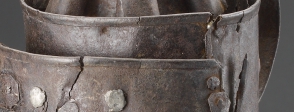These activities and approaches are for younger students and suggest ways of moving out from history into cross-curricular work.
Use the object as a classroom mystery object. Display an image of the object at the end of October or start of November with a response board for students to add comments or questions about the object. Use these responses as the starting point for leading the students into finding out about the object as part of a history lesson about Guy Fawkes and the Gunpowder plot.
How have people made light in the past? Find out about different methods used to create light in the past. Use the objects included in A bigger picture to create a lighting timeline and start off a study of lighting through time. These objects are also useful for discussing associated vocabulary as the words light, lamp, lantern and torch are often used interchangeably as well as often having a specific type of lighting device associated with them.
The rhyme shown below is a traditional rhyme spoken for hundreds of years and exists in a large number of variations. The rhyme mentions the lantern at the end of the rhyme. Write a new Guy Fawkes verse with the students.
Remember, remember the fifth of November
Gunpowder, treason and plot
I see no reason
Why gunpowder treason
Should ever be forgot.
Guy Fawkes, Guy Fawkes, t’was his intent
To blow up the king and parliament.
Three score barrels of powder below
Poor old England to overthrow;
By God’s providence he was catched
With a dark lantern and burning match.
Conduct a counterfactual enquiry – what do the students think might have happened if Guy Fawkes had not been discovered in the cellars of the Houses of Parliament that night?
Investigate the commemorations and festivals that take place between September and December in different countries. Identify the different reasons for these, such as remembering an event or person, marking a traditional custom such as harvest, symbolically maintaining light as winter draws on.
Discuss the objects in A bigger picture. Some of these have a functional use and a symbolic meaning, such the lights in a place of worship which represent the light of God or the solar-powered lamp offering light in areas of the world with no electricity. You could explore this idea in relation to Florence Nightingale who was known as the Lady of the Lamp – see Florence Nightingale’s writing box.
Compare and contrast the lantern with a modern torch. Create a comparison chart to record what is the same and what is different about the two light devices. Compare attributes such as the materials used to make the device, the means of making light, the power source, how to turn it on, how to turn it off, how to hold it.
Go on a light survey to identify and record all the different kinds of light sources to be found around the school. What other natural and artificial sources of light are there? Use the two websites in For the classroom to start thinking about what objects act as sources of light. Both websites can be loaded onto a whiteboard for use with the whole class.
Investigate the transparency and opacity of materials. Test different materials to see which would work best as the window in a lantern. Test each material to see which lets the most light through. The lantern had an inner cylinder which could be twisted round to hide the light. Test a range of materials to find out which are best for making a cover for a dark lantern.


